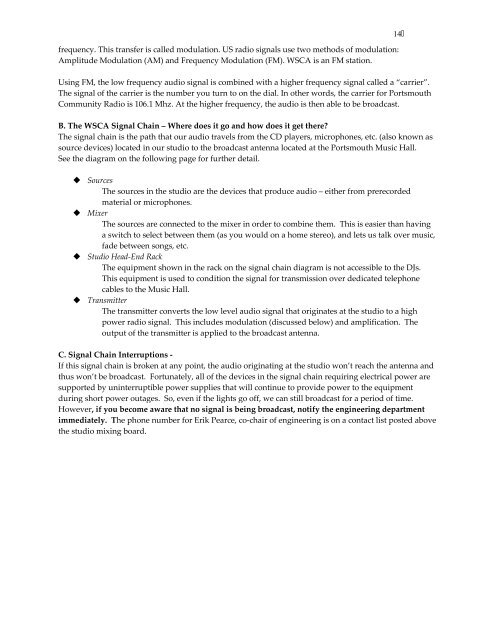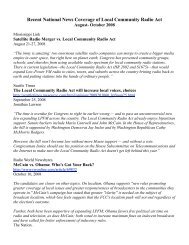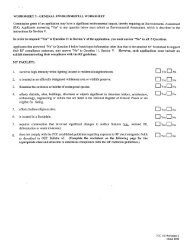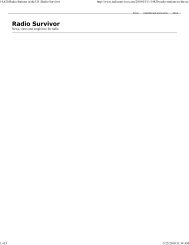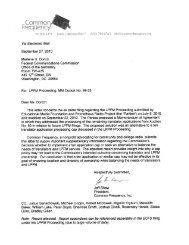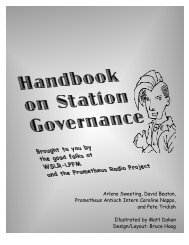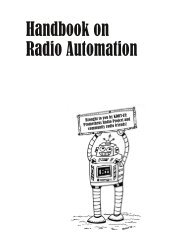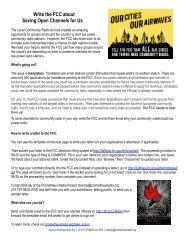WSCA Station Handbook and Training Manual - Prometheus Radio ...
WSCA Station Handbook and Training Manual - Prometheus Radio ...
WSCA Station Handbook and Training Manual - Prometheus Radio ...
Create successful ePaper yourself
Turn your PDF publications into a flip-book with our unique Google optimized e-Paper software.
frequency. This transfer is called modulation. US radio signals use two methods of modulation:<br />
Amplitude Modulation (AM) <strong>and</strong> Frequency Modulation (FM). <strong>WSCA</strong> is an FM station.<br />
Using FM, the low frequency audio signal is combined with a higher frequency signal called a “carrier”.<br />
The signal of the carrier is the number you turn to on the dial. In other words, the carrier for Portsmouth<br />
Community <strong>Radio</strong> is 106.1 Mhz. At the higher frequency, the audio is then able to be broadcast.<br />
B. The <strong>WSCA</strong> Signal Chain – Where does it go <strong>and</strong> how does it get there?<br />
The signal chain is the path that our audio travels from the CD players, microphones, etc. (also known as<br />
source devices) located in our studio to the broadcast antenna located at the Portsmouth Music Hall.<br />
See the diagram on the following page for further detail.<br />
Sources<br />
The sources in the studio are the devices that produce audio – either from prerecorded<br />
material or microphones.<br />
Mixer<br />
The sources are connected to the mixer in order to combine them. This is easier than having<br />
a switch to select between them (as you would on a home stereo), <strong>and</strong> lets us talk over music,<br />
fade between songs, etc.<br />
Studio Head‐End Rack<br />
The equipment shown in the rack on the signal chain diagram is not accessible to the DJs.<br />
This equipment is used to condition the signal for transmission over dedicated telephone<br />
cables to the Music Hall.<br />
Transmitter<br />
The transmitter converts the low level audio signal that originates at the studio to a high<br />
power radio signal. This includes modulation (discussed below) <strong>and</strong> amplification. The<br />
output of the transmitter is applied to the broadcast antenna.<br />
C. Signal Chain Interruptions ‐<br />
If this signal chain is broken at any point, the audio originating at the studio won’t reach the antenna <strong>and</strong><br />
thus won’t be broadcast. Fortunately, all of the devices in the signal chain requiring electrical power are<br />
supported by uninterruptible power supplies that will continue to provide power to the equipment<br />
during short power outages. So, even if the lights go off, we can still broadcast for a period of time.<br />
However, if you become aware that no signal is being broadcast, notify the engineering department<br />
immediately. The phone number for Erik Pearce, co‐chair of engineering is on a contact list posted above<br />
the studio mixing board.<br />
14


